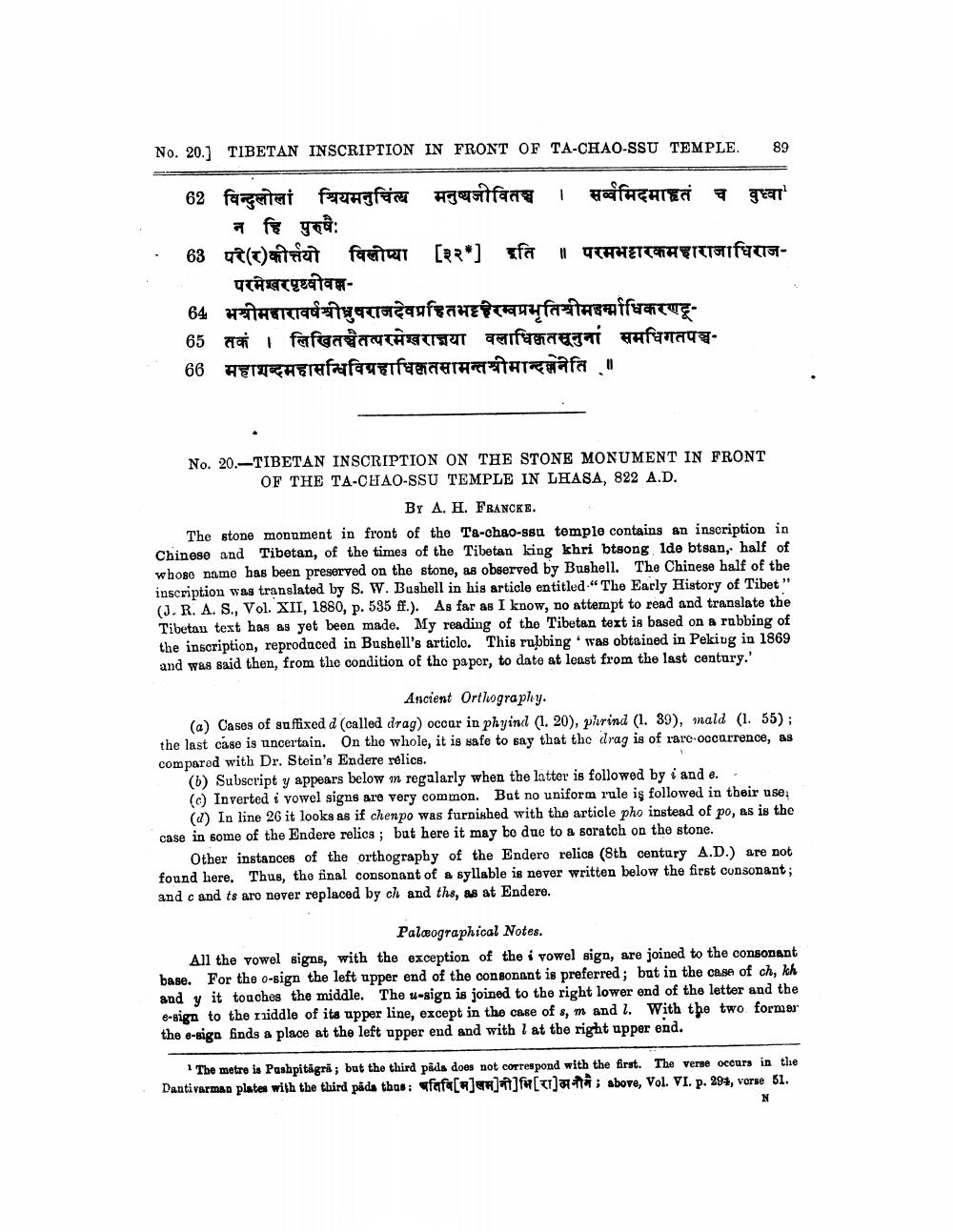________________
No. 20.] TIBETAN INSCRIPTION IN FRONT OF TA-CHAO-SSU TEMPLE.
62 विन्दुलोलां श्रियमनुचिंत्य मनुषजीवितच । सर्व्वमिदमाहृतं च वुध्वा' न हि पुरुषः
63 परे (र) कीर्तयो विलोप्या [२२] इति ॥ परमभट्टारकमहाराजाधिराजपरमेश्वर पृथ्वीवल
64 मत्रीमदारावर्षीभुषराजदेवप्रहितभरस्वप्रभूतिश्रीमहम्र्माधिकरण
65 तकं । लिखितश्चैतत्परमेश्वराज्ञया वलाधिक्कतसूनुनां समधिगतपञ्च66 महाशब्दमहासन्धिविग्रहाधिक्कृतसामन्तश्रीमान्दनेनेति ॥
89
No. 20.-TIBETAN INSCRIPTION ON THE STONE MONUMENT IN FRONT OF THE TA-CHAO-SSU TEMPLE IN LHASA, 822 A.D.
BY A. H. FRANCKE.
The stone monument in front of the Ta-chao-ssu temple contains an inscription in Chinese and Tibetan, of the times of the Tibetan king khri btsong lde btsan, half of whose name has been preserved on the stone, as observed by Bushell. The Chinese half of the inscription was translated by S. W. Bushell in his article entitled "The Early History of Tibet" (J. R. A. S., Vol. XII, 1880, p. 535 ff.). As far as I know, no attempt to read and translate the Tibetan text has as yet been made. My reading of the Tibetan text is based on a rubbing of the inscription, reproduced in Bushell's article. This rubbing was obtained in Peking in 1869 and was said then, from the condition of the paper, to date at least from the last century.'
Ancient Orthography.
(a) Cases of suffixed d (called drag) occur in phyind (1. 20), phrind (1. 39), mald (1. 55); the last case is uncertain. On the whole, it is safe to say that the drag is of rare occurrence, as compared with Dr. Stein's Endere relics.
(b) Subscript y appears below m regularly when the latter is followed by i and e.
(c) Inverted i vowel signs are very common. But no uniform rule is followed in their use. (d) In line 26 it looks as if chenpo was furnished with the article pho instead of po, as is the case in some of the Endere relics; but here it may be due to a scratch on the stone.
Other instances of the orthography of the Endere relics (8th century A.D.) are not found here. Thus, the final consonant of a syllable is never written below the first consonant; and c and ts are never replaced by ch and ths, as at Endere.
Palæographical Notes.
All the vowel signs, with the exception of the i vowel sign, are joined to the consonant base. For the o-sign the left upper end of the consonant is preferred; but in the case of ch, kh and y it touches the middle. The u-sign is joined to the right lower end of the letter and the e-sign to the riddle of its upper line, except in the case of s, m and l. With the two former end. the e-sign finds a place at the left upper end and with l at the right upper
1 The metre is Pushpitägrä; but the third pads does not correspond with the first. The verse occurs in the Dantivarman plates with the third pada thus: «fafa[a]]]f[]; above, Vol. VI. p. 294, verse 51.
N




